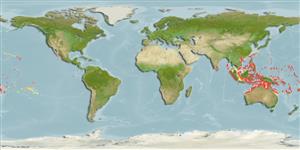Common names from other countries
Issue
The synonym P. quadrispinosa (Weber, 1913) is valid and redescriberd according to Johnson & White, 2012 (Ref. 90268).
Environment: milieu / climate zone / depth range / distribution range
Ecologia
marino associati a barriera corallina; distribuzione batimetrica 0 - 100 m (Ref. 128797). Tropical; 30°N - 24°S
Indo-West Pacific: India and Sri Lanka to Tonga (Ref. 53797); , Ryukyu Islands and the Great Barrier Reef to the Marshall Islands and Samoa. Recently recorded from
Size / Peso / Age
Maturity: Lm ? range ? - ? cm
Max length : 24.0 cm TL maschio/sesso non determinato; (Ref. 48636)
Spine dorsali (totale) : 4 - 5; Raggi dorsali molli (totale) : 20 - 21; Spine anali: 1; Raggi anali molli: 17. A row of small blackish spots in outer third of anal fin (Ref 42740). Males develop a conspicuous ocellus on each side of the nape (Ref. 1602). Young are best identified by the patch of small spots on the cheek that usually remains evident in adults (Ref. 48636).
Inhabits both clear lagoon and seaward reefs, in areas of open sand and rubble as well as on rocky surfaces between coral heads. Also in current prone channels (Ref. 48636). May be found solitary or form small groups (Ref. 90102).
Life cycle and mating behavior
Maturities | Riproduzione | Spawnings | Egg(s) | Fecundities | Larve
Randall, J.E., G.R. Allen and R.C. Steene, 1990. Fishes of the Great Barrier Reef and Coral Sea. University of Hawaii Press, Honolulu, Hawaii. 506 p. (Ref. 2334)
IUCN Red List Status (Ref. 130435)
CITES (Ref. 128078)
Not Evaluated
Threat to humans
Harmless
Human uses
Strumenti
Special reports
Download XML
Fonti Internet
Estimates based on models
Preferred temperature (Ref.
115969): 26.1 - 29, mean 28 (based on 586 cells).
Phylogenetic diversity index (Ref.
82804): PD
50 = 0.5000 [Uniqueness, from 0.5 = low to 2.0 = high].
Bayesian length-weight: a=0.00692 (0.00311 - 0.01538), b=3.06 (2.88 - 3.24), in cm Total Length, based on LWR estimates for this Genus-body shape (Ref.
93245).
Trophic level (Ref.
69278): 3.6 ±0.4 se; based on size and trophs of closest relatives
Resilienza (Ref.
120179): Alto, tempo minimo di raddoppiamento della popolazione meno di 15 mesi (Preliminary K or Fecundity.).
Fishing Vulnerability (Ref.
59153): Low vulnerability (18 of 100).
